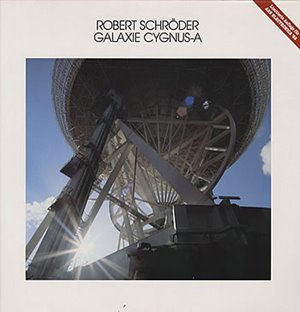Despite titles like “Alpha Centauri” and “Fly and Collision of Comas Sola,” in spite of covers that seemed blown out of distant nebulae and regardless of music that, well, just listen to it, Edgar Froese always claimed that Tangerine Dream didn’t make space music. Robert Schröder‘s Galaxie Cygnus-A, however, is a space music album in every sense. It takes its inspiration, and reputedly some of its sonic pallette, from radio wave transmissions from the title galaxy. We tune it in tonight, October 21, on Echoes.
Schröder put this album length epic together for the 1982 Ars Electronica Festival in Linz, Austria as a multimedia collaboration with visual artist Michael Weisser who went on to form the space music band, Software.
While everyone seems to be reissuing every electronic fart and burp they ever recorded, Galaxie Cygnus-A, released in a limited edition on Klaus Schulze’s Innovative Communications label, has never been issued on CD. That makes it a true lost star in the constellation of classic ’70s Berlin school electronics, even if it was recorded in 1982.
Schröder created an electronic symphony that traverses beatless spacescapes swept by sustained chords and electronic bursts, dotted by sample and hold patterns and squiggly sounds that dart through the spectrum like cyber-gnats. But it also has moments of propulsive, hypnotic rhythms . This was recorded a fraction of a second before samplers and digital synthesis were omnipresent, so the sounds are analog and many of them come from instruments that Schröder designed himself. An ominous pizzicato riff stalks through a dark twilight landscape in the second movement, sounding like a string pluck with a percussive attack and dampened decay, but it’s purely electronic. Schröder swirls electronic sounds around it, while improvising a reedy synth lead line.
Side two is centered by a waltz-like sequencer pattern counterpointed by a harpsichord arpeggio line and a sound like a sword whipping past your ears. Schroder patiently creates a slowly evolving balancing act floating in space. The original album had a locked groove at the end of each side that ran out into the hiss and gurgle of white noise or radio transmissions.
There’s a question whether the sounds are actually signals from the galaxy picked up by a radio telescope or if it’s simply white noise. That’s the claim of Klaus D. Mueller, the publisher and de facto manager of Klaus Schulze, who started Innovative Communications.
Klaus D. Mueller: This “Galaxy” hook (sending and receiving sounds from the Galaxy so-and-so) was a fake (Weisser’s speciality) made especially for a live show at the “Ars Electronica” in Linz, Austria, in the early eighties. These “live” sounds, allegedly coming from this Galaxy, was simply a prerecorded tape with “white noise.” (Later, someone showed me a letter from Weisser where he mentions this technical detail….,)
However, in an email Robert Schröder sent to me, he disputes this assertion.
Robert Schröder: The noise at the beginning and between a few tracks of Galaxie-Cygnus-A is
original space noise from these radio galaxie. The noise was received and
recorded by the big radio telescope in Effelsberg (Eifel /Germany).
It is not true what K.D.M. says.
You can’t get Galaxy Cygnus-A at this time, but someone on YouTube put pictures to the best movement from that work.
Robert Schröder was from the second generation of German space musicians, a decade or more younger than Klaus Schulze and most members of Tangerine Dream and Kraftwerk. He started out building his own electronic gear which looked and sounded a lot like the Moog and Arp synthesizers out at the time. He came under the wing of electronic pioneer Klaus Schulze when Schroder asked the synthesist to be the godfather of his son, Klaus. Schulze signed him to his Innovative Communications label and he went on to record several albums, including his debut, the acoustically tinged Harmonic Ascendant which mixed cello and acoustic guitar with his electronics and the chromium sequencer timbres of Floating Music. He’s put out several more albums and also recorded with the more pop oriented electronics of Double Fantasy, which turned into Dancing Fantasy, and now its called, Food for Fantasy, a project of diminishing returns and increasing corniness.
We’ll feature music from Robert Schröder’s Galaxy Cygnus-A in an Ancient Echo this Tuesday, October 21
John Diliberto ((( echoes )))


I’ve updated this post to reflect Robert Schroder’s counter to Klaus D. Mueller’s assertion that the radio signals used on Galaxy Cygnus-A were fake.
From the ARS Electronica Linz archive, notes for the 1982 concert:
http://www.aec.at/en/archiv_files/19821/E1982_190.pdf
That’s great information. Thanks.
Edgar on space music….“When we started we called it ‘Cosmic music’ unfortunately the people we worked with, in the business ‘occupied’ it as a trade mark and used it terribly and nearly everything that they produced on their label was called cosmic music because they realised that it would be selling much better than just calling it dance music or rock ‘n’ roll or whatever. As soon as we realised that we cut it, all these explanations off, and we said we didn’t want anything to do with it, but specifically because we were betrayed. On the other hand we still call it that way and we feel very much obliged that everything which is something to do with space.
We are located very precisely and very accurately on an orbit which has an interconnection to so many other Planets, we are part of that, so we are part of space, that’s what we are.
Do you realize you’re quoting back my own interview with Tangerine Dream? Probably from the early 1980s.
Oh yes…that’s why I posted it 🙂